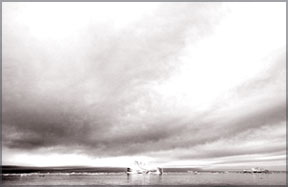
Arctic ice melt opens Northwest Passage
Arctic ice has shrunk to the lowest level on record, new satellite
images show, raising the possibility that the Northwest Passage that
eluded (escaped the attention) famous explorers will become an open
shipping lane.
The European Space Agency said nearly 200 satellite photos taken this
month showed an ice-free passage along northern Canada, Alaska and
Greenland, and ice retreating to its lowest level since such images were
first taken in 1978.
|

An iceberg melting off Ammassalik Island in Eastern
Greenland Pic: AP |
The waters are exposing unexplored resources, and vessels could trim
thousands of miles from Europe to Asia by bypassing the Panama Canal.
The seasonal ebb and flow of ice levels has already opened up a slim
summer window for ships.
Leif Toudal Pedersen, of the Danish National Space Center, said that
Arctic ice has shrunk to some one million square miles. The previous low
was 1.5 million square miles, in 2005.
"The strong reduction in just one year certainly raises flags that
the ice (in summer) may disappear much sooner than expected," Pedersen
said in an ESA statement posted on its website.
Pedersen said the extreme retreat this year suggested the passage
could fully open sooner than expected - but ESA did not say when that
might be. Efforts to contact ESA officials in Paris and Noordwik, the
Netherlands, were unsuccessful.
A U.N. panel on climate change has predicted that polar regions could
be virtually free of ice by the summer of 2070 because of rising
temperatures and sea ice decline, ESA noted.
Russia, Norway, Denmark, Canada and the United States are among
countries in a race to secure rights to the Arctic that heated up last
month when Russia sent two small submarines to plant its national flag
under the North Pole.
A U.S. study has suggested as much as 25 per cent of the world's
undiscovered oil and gas could be hidden in the area.
Environmentalists' fear increased maritime traffic and efforts to tap
natural resources in the area could one day lead to oil spills and harm
regional wildlife.
Until now, the passage has been expected to remain closed even during
reduced ice cover by multiyear ice pack - sea ice that remains through
one or more summers, ESA said.
Researcher, Claes Ragner of Norway's Fridtjof Nansen Institute, which
works on Arctic environmental and political issues, said for now, the
new opening has only symbolic meaning for the future of sea transport.
"Routes between Scandinavia and Japan could be almost halved, and a
stable and reliable route would mean a lot to certain regions," he said.
But even if the passage is opening up and polar ice continues to melt,
it will take years for such routes to be regular, he said.
"It won't be ice-free all year around and it won't be a stable route
all year," Ragner said. "The greatest wish for sea transportation is
streamlined and stable routes."
"Shorter transport routes means less pollution if you can ship
products from A to B on the shortest route," he said, "but the fact that
the polar ice is melting away is not good for the world in that we're
losing the Arctic and the animal life there."
The opening observed was not the most direct waterway, ESA said. That
would be through northern Canada along the coast of Siberia, which
remains partially blocked.
- AP |
